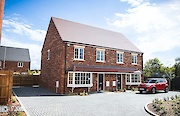


Mortgage Advisor & Director

Mortgage Advisor & Director

If you’re looking for information about which home ownership schemes are available in the UK, you’ve come to the right place. In this article, we look at government mortgage schemes, as well as home ownership schemes offered elsewhere across the UK.
No matter where in the UK you’re looking to buy a home, we list the schemes available to you, signpost to more detailed articles on each, and explain how we can help along the way.
What government mortgage schemes are available UK-wide?
Since the devolution of the UK, each nation tends to have its own range of country-specific government mortgage schemes. However, some are available nationwide, such as:
The shared ownership scheme
One of the longest-running home ownership schemes, Shared Ownership allows you to buy between 10% and 75% of a property if you can’t afford a mortgage for the full value. A housing association or local council retains ownership of the remainder, which you pay rent to them for until you can afford to buy more.
The intention is that you increase your ownership over time until you own 100% (although this is not possible with all housing associations, so be sure to check the terms). This is a process known as staircasing, and ownership can be increased in increments as small as 1% at a time.
Who can apply?
-
Those who earn £80,000 or less (£90,000 if you live in London)
-
Do not own any other properties
-
Will only use the home to live in, not to rent out
-
Be a permanent UK resident
The older people’s shared ownership scheme
The Older People’s Shared Ownership Scheme works the same as the standard scheme but is only available to those over 55. The only other difference is that buyers can only ever own a maximum of 75% of their property, although when they reach that level of ownership they will no longer need to pay rent on the remaining 25%.
Who can apply?
-
Over 55s with permanent UK residency
-
Have a maximum income of £80,000 or £90,000 in London
-
Not own any other property, unless already a member of standard shared ownership scheme
Schemes only available in England
If you’re looking to buy in England, then you have the widest range of home ownership schemes available to you. However, keep in mind that average house prices in England tend to be higher overall, making it more challenging to get onto the property ladder in many areas, especially the South and South East of the country.
The right to buy and right to acquire schemes
The Right to Buy scheme enables certain council tenants to buy their rented home from the council at a discount as high as 70%. The actual size of the discount depends on their length of time as a council tenant. This is not available to all council tenants, however. Many councils are unable to sell off their housing stock due to a shortage of properties.
The right-to-acquire scheme operates similarly, but is aimed at housing association tenants, rather than council tenants. There is a much lower maximum discount of up to £16,000 off the total property value. Some lenders allow this to be used in place of a deposit when taking out a mortgage with them.
Who can apply?
-
Social housing tenants
-
Criteria are specific to each council or housing association, you can find out more on the individual scheme pages for Right to Buy and Right to acquire through the links.
The Rent to Buy scheme
The Rent to Buy scheme is offered by various housing associations throughout England and may be known by different names in different areas. The terms and criteria also vary by housing association. However, they all allow prospective buyers to rent a property at a reduced market rent, helping them save a deposit to purchase the home later.
Who can apply?
-
Applicants with an annual household income below £60,000
-
Who doesn’t own any property
-
Specific criteria also apply which vary by housing association
The first homes scheme
The First Homes Scheme allows buyers to purchase certain new build properties at 30% to 50% below their market value. These homes are available to all who qualify, but key workers, those on a low income, and people with local connections to the area tend to be given priority to them.
To ensure a long-term supply of affordable housing, these properties can only be resold to other qualifying applicants, and at the same discount they were purchased at.
Who can apply?
-
First-time buyers in England
-
Have a household income of £80,000 or less (£90,000 in London)
-
Who does not own other property
-
Must also qualify for a mortgage of at least 50% of the discounted property value
Homeownership schemes by property developers

In recent years, we’ve seen home builders and property industry alliances launching their own schemes, which are not associated with the government. This is largely in an attempt to replace the popular government help-to-buy scheme, which has now ended across most of the UK.
Own New - Rate Reducer
This scheme is a collaboration between finance firm, Own New, and a range of lenders and home builders. They utilise house builder incentives, which would typically be offered as a discount or cashback, but instead, offset them against mortgage interest to enable lenders to offer very low rates in the first few years of a mortgage.
This reduces the monthly repayments in the initial years of repayment, enabling buyers to remortgage to a longer-term preferential rate, once they have gained some equity in their home.
Who can apply?
-
Unlike most government schemes, both first-time buyers and home movers can apply
-
There are currently a handful of lenders offering this scheme and the criteria will depend on which lender you apply with
The deposit unlock scheme
Deposit unlock was the first non-government home ownership scheme, introduced back in 2022 by the Home Builders Federation. It provides new build homes that are available to buy with a 5% deposit. Typically at least a 15% deposit is required to purchase a new-build home, making it unaffordable to many prospective buyers.
Who can apply?
-
Both first-time buyers and home movers can apply
-
You must have 5% deposit
-
You can only get a mortgage with a lender who partners with the scheme, accessible through mortgage brokers only
Schemes only available in Scotland
The two government mortgage schemes Scotland has available sit under the same scheme, which is known as LIFT (Low Cost Initiative for First-time Buyers). Although the schemes differ slightly, the terms apply to both schemes:
Open Market Shared Equity (OMSE) helps people to buy a home that’s for sale on the open market, within a certain price threshold (dependent on individual region). The government provides 10- 60% of the value through a shared equity agreement, which you won’t need to pay back until you sell the home on.
The New Supply Shared Equity scheme (NSSE) is where the Scottish Government provides a shared equity arrangement of 20-40% towards the cost of a council or housing association property. You own the property outright, and the government is not named on the property deed as a joint owner.
However, when you sell the property, the government takes the same percentage share (20-40%) of the sale price that they provided as an equity loan.
Who can apply?
-
Lower-income households depending on region, but each council will assess this and usually prioritise over 60s, military personnel, and social housing tenants
-
You must not own any other property
-
You will need to qualify for a repayment mortgage for the remainder of the property value
Schemes only available in Northern Ireland
The only home ownership scheme specific to Northern Ireland is the Co-ownership scheme, which is a collaboration between the government, and housing developers, among other property industry partners. However, residents of Northern Ireland also have access to some of the UK-wide schemes, such as the Right to Buy scheme (England).
The co-ownership scheme allows you to buy at little as 50% or as much as 90% of a property up to the value of £195,000, depending on what you can afford. You then pay rent on the remaining share to Co-ownership. You can increase ownership at 5% increments as and when you can afford to buy more, which is known as ‘buying out’.
Who can apply?
-
You must not be able to buy a home through a traditional mortgage
-
You must be able to afford the repayments and rent
-
You must pay a non-refundable £100 application fee to be assessed for ownership
Schemes only available in Wales

If you’re looking to buy a home in Wales, there are government mortgage schemes to consider alongside the national schemes open to all UK applicants. Those specific to Wales are:
The Homebuy scheme
Homebuy is an equity loan scheme similar to the help to buy scheme, which enables buyers to purchase a new build property with around 30% equity from the Welsh government. This means you will only need to qualify for a mortgage to cover 70% of the property value. However, unlike help to buy, the loan will not need to be repaid until you sell the home. It’s a largely rural scheme, so not available in all areas of Wales.
Who can apply?
-
Social housing tenants or those who can’t afford a home to meet their needs, including their current home, if it’s become unaffordable
-
You’ll need to qualify for a repayment mortgage for the remaining 70% of the property value
-
Each council may have additional local criteria
The rent to own Wales scheme
Rent to Own enables applicants to rent a home in Wales to build up a lump sum towards a deposit to purchase the home at a later date. This is facilitated by giving the tenant 25% of the rent they’ve paid throughout the tenancy back to be used as a deposit. They will also receive a 50% discount on any increase in the property value during their tenancy.
The agreement lasts for up to 5 years, but you can apply to buy the home after 2 years, assuming you have enough deposit. Properties can only be purchased through an approved landlord.
Who can apply?
-
Applicants must have a total household income of £60,000 or less
-
Must not be eligible for housing benefit
-
Must not own a home anywhere in the world (unless a court order forces you to remain on the deeds of a property where your children live)
-
Must be unable to afford to buy a suitable home on the open market
-
Must be able to afford the rent of your selected property
How to choose the right scheme for you
There are a substantial number of schemes available across the UK, and the most suitable will depend on both your personal circumstances and where in the UK you are based.
Whichever scheme you apply for, you’ll need to qualify for a suitable mortgage product with a lender who accommodates the scheme. It’s a good idea to speak to a broker, like ourselves, to see which lenders might be available to you, before you make a decision on which is the most suitable scheme.
We deal with a wide range of government mortgage scheme applications every day, so can happily provide advice and guidance on both the schemes and the relevant mortgage products to use in conjunction with them.

Begin your mortgage journey...
Is the Help to Buy scheme still available?
The Help to Buy scheme is still available in Wales until 31 March 2025 but is no longer available in the rest of the UK. The Welsh government provides an equity loan of up to 20%, which can be used towards the deposit for a home up to the value of £300,000. You don’t need to pay this back for the first 5 years, but from the 6th year onwards you will accumulate monthly interest on the loan.
Who can apply?
-
You must not use the scheme to buy a second home, or a property to rent out
-
You must have a 5% deposit available
-
You must be able to qualify for a repayment mortgage to cover the remaining 80% of the property value
Forces help to buy
There is also a similar help-to-buy scheme solely for members of the armed forces, the forces help to buy scheme. It works slightly differently, allowing members of the UK armed forces to borrow up to 50% of their salary (up to £25,000) towards a property purchase. Unlike the standard help-to-buy scheme, this can also be used with other home ownership schemes that may be available in the area where you buy a home.
Who can apply?
-
Members of the armed forces who plan to live in the home or have their immediate family live there
-
They must not own a home unless it will be sold before ownership commences
-
Personnel must have completed phase 1 training and have enlisted at least 12 months ago
-
You must also have at least six months remaining in the forces and not be under warning or discharge
-
You must have no outstanding Crown Debt and not have drawn any terminal benefits
Why choose Teito for your mortgage needs?
At Teito, we can provide guidance on the availability of home ownership schemes in your area, help you determine whether you’ll qualify, and help you secure the most suitable mortgage to use alongside it. Whether you’re a first-time buyer, or struggling to get back onto the property ladder with a traditional mortgage, our experienced brokers will support you throughout your journey to home ownership.
We provide:
-
A 5-star rated service
-
Free initial consultation with no obligation
-
A free comparison of 1000s of mortgage products in seconds
-
Help with both scheme and mortgage application paperwork
Get started here to get advice about government schemes and book a free, no-obligation chat with a broker who can offer support.
FAQs
As well as mortgage schemes, government ISAs are intended to help those struggling to save for a house deposit, to do so more quickly. While the Help to Buy ISA no longer accepts applications, the Lifetime ISA (LISA) is still available to all UK residents under 40.
A LISA allows you to save up to £4,000 a year, which the government then tops up by 25% - so a maximum of £1000 per year. The money can only be withdrawn as a deposit to buy a home, or if you’re over 60 or terminally ill, otherwise you lose the 25% bonus.
Choosing an Adviser
Selecting a qualified and experienced mortgage adviser is of great importance. To choose a suitable adviser, evaluate their qualifications, experience, and reputation, and ensure they are regulated by the Financial Conduct Authority (FCA).
Read reviews from previous clients and make sure they provide a clear explanation of the products and services they offer, as well as the fees and charges associated with them.
























































































































































